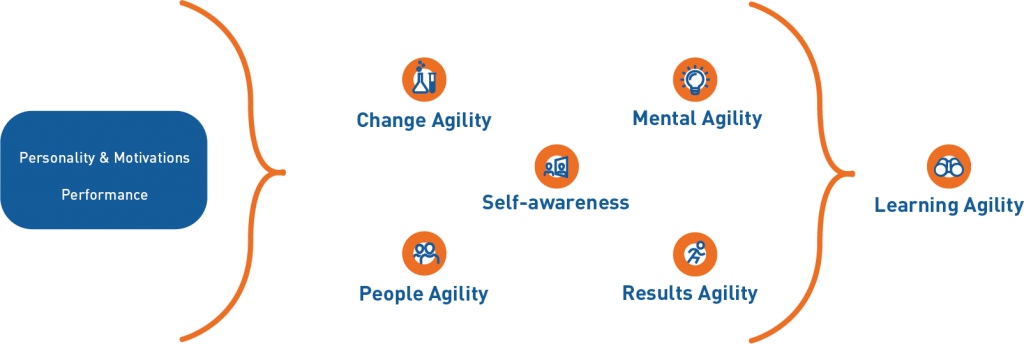
Agile working and Learning Agility – a match made in heaven?
Agile working and Learning Agility – a match made in heaven?
By: Evelien Schram and Jan Meijning
Agile working, an agile mindset and learning-agile people. The term Agility is now commonplace and has gone past the buzzword status. Agile has become the way in which more and more organisations plan their work. Not just in the IT department, but throughout the organisation. Google Agile HR or Agile Marketing, and you'll be inundated with articles and training programmes. If your organisation chooses agile working, do you need people who are learning agile or is that nonsense?
Why switch to agile working methods?
Agile working seems to have become the standard in many organisations, but what makes it so popular? The advantages of agile working seem evident, with the result component being the main driver. Everyone is familiar with examples of (traditionally often ICT) projects that consistently pass their deadline and at the end of the journey no longer reflect the reality of today's requirements because the original plan has become outdated. By working in smaller steps and delivering (preliminary) results that are still relevant and testing whether they work and fit customer requirements and the desired result, we can seek and find faster, more creative and more pragmatic solutions. The ability to respond flexibly to increasingly rapid changes caused by technological developments, globalisation and/or economic circumstances enables you to stay ahead of the field as an organisation.
A history lesson - the Agile Manifesto
2001 (now nearly 2 decades ago!): A group of software experts spent several days holed up in the snow-capped mountains of Utah because they firmly believed that a much smarter and more effective approach to software development was possible.
This meeting produced a statement about how you can work efficiently and quickly to achieve the best result in a (software development) project. It was no longer the case that a detailed plan first had to be drawn up, which was then meticulously elaborated and followed step by step until the project was completed. Now small (multidisciplinary) teams would work in short sprints on (preliminary) results, constantly reviewing progress to ultimately achieve the desired result. They published the Agile Manifesto:

Organisation-wide agile working
In many organisations, agile working methods are naturally first adopted by IT/development departments. Switching to agile working in other places than just the IT department feels logical. Agile HR or Agile Marketing might initially sound strange, but in a rapidly changing world like ours, (traditional) working processes are often no longer effective because they are slow or cumbersome. If you can't respond to new technological developments and changing customer requirements, you will soon miss the boat. That not only applies to IT, but to other departments in the organisation too.
miss the boat or not?
There are too many examples of (big) companies that have gone under because they were unable to adapt fast enough to the new reality. Without naming names: if a physical clothes department store fails to respond in a timely and effective way to new online options, you're asking for problems. The customer soon gets used to the new situation and switches more easily to competitors and newcomers than expected or hoped. If you can work more flexibly as an organisation, you can change course faster if the market requires it. That's why organisations have increasingly adopted agile working. You see more and more job titles based on agile ways of working: Scrum Master, Product Owner or even Vibe Manager. Apart from all the new titles now displayed on LinkedIn, working in (multidisciplinary) teams that can adjust fast, that can experiment and deliver (preliminary) results, has enhanced the impact of organisations.
An agile organisation with Learning Agility
First the definition: Learning Agility is people's ability to develop new effective behaviour quickly and based on new experiences, and then to apply this behaviour successfully. This is a form of learning or change ability, or learning and change potential. People who score high on Learning Agility learn more and faster in new situations. They can derive more from their experiences and are constantly looking for new challenges. They request feedback so that they can learn and recognise patterns in unfamiliar situations and bring in others effectively to understand and make sense of experiences.
Yes, another history lesson - Learning Agility
Learning Agility is no longer a new term and has a longer history than often thought (in Europe). At the start of the 21st century, the term emerged in America and measuring Learning Agility was mainly applied to the theme of leadership. Funnily enough, by using 360-degrees feedback. Seeking leaders of the future by looking at the qualities of today might seem illogical, but the term was quickly embraced. Research soon revealed that a high degree of Learning Agility had a predictive value for successful (work) behaviour in an unknown future. Learning Agility is measured in five dimensions:

Agile working with learning-agile people?
Do you need flexible, learning-agile people if your organisation uses an agile working method? Yes and no. Agile working is a working method. This is an established method that is guiding and categorised in clear rules and elements that everyone recognises. In fact, very strictly prescribed. From A to B and then perhaps back to A and via C back to B, but still according to the fixed steps and prescribed parts. Learning Agility is people's ability to quickly find new effective solutions in changing circumstances and then to apply these immediately. Outside the buzzword agility, agile working as a strictly, clearly described working method and Learning Agility as flexible learning/change potential don't therefore seem to have much in common. For an established working method, you don't need to be agile. Do you?
New experiences - changing circumstances
Nothing is less true. The words new and change are very important here. Learning-agile people manage change more easily, even initiate it and learn how to deal with the changing reality of the day more quickly and effectively. And, back to the basis, this was and is obviously the principle of the agile way of working. The ability of an organisation to achieve the requested, and above all the not yet requested, result more quickly and flexibly.
And this is the match between agile working and Learning Agility. Not in the agile, prescribed working method itself, but in the why and how. Most ways of agile working (scrum, lean, etc) place the emphasis on the following: cooperation in (multidisciplinary) teams, delivering workable preliminary results, experimentation and being allowed to make mistakes, communication and transparency, reflection moments and asking for help if you need it. And this is exactly where Learning Agility plays an important role!
Does everyone need to be super learning agile?
Research has shown that people with higher Learning Agility not only learn more quickly in an unfamiliar situation, their current performance is often better too. If your organisation switches to agile working methods, it is very useful to have a group of people with high(er) Learning Agility. Such a switch is a considerable change for people and requires a healthy dose of learning/change ability to be able to implement it effectively and successfully. In situations where it is clear what's expected of someone, when work is based more on routine procedures and there are few, if any, changes, being extremely learning agile isn't a must.
In fact, there are some professions where you'd prefer to have someone who doesn't love experimenting. An air traffic controller or a crane operator who suddenly thinks it might be nice to do things completely differently today? No thanks! And there are other jobs where you would certainly prefer people not to be too flexible and experimental.
But the same applies to these jobs too: the world is no longer static. Nearly every job faces change. Even an air traffic controller, pilot, mechanic or crane operator faces changing requests and circumstances. And the more learning agile someone is, the more easily and quickly they adjust. In other words: Learning Agility does not reflect how skilled the crane operator is in his current type of crane, but more about how quickly he can switch to another working method for a different type of crane.
Agile working and Learning Agility – a match?
A match made in heaven might sound exaggerated, but the combination of agile working and Learning Agility is certainly useful. Fail fast, learn faster is a saying that relates to agile working. And it also applies very well to Learning Agility. Even the previously mentioned importance of cooperation, reflection and the other basic elements involved in agile working methods requires a higher degree of Learning Agility.

The light blue terms are important in agile working methods and fit in very well with the different Learning Agility dimensions.
If you have a combination of the above qualities, you can switch more quickly and effectively if something new is required of you. And that's Learning Agility. During a meeting about Learning Agility with a big group of IT employees, this comment was made: ‘So agile working also means working on my Results Agility!’ This is a bit simplistic, but agile working and Learning Agility can certainly strengthen each other.
Can you develop Learning Agility?
Luckily you can! Learning Agility is measured by a combination of who you really are and what you want or feel is important, perhaps combined with your current behaviour in practice (doing).

It's this combination measurement that provides a complete and nuanced picture. By only basing a Learning Agility measurement on personality/potential or on just motivations or just current behaviour, you do people an injustice. If you merely look at people's basic skills, you miss what people want. And a measurement based solely on current behaviour to predict effective behaviour in an unknown future is too limited and narrow.
Self-awareness as lever for development
By focusing on the Learning Agility dimension of Self-awareness, there are benefits to be gained. Self-awareness concerns the extent to which someone recognises their own strengths and weaknesses and is willing to develop. Self-awareness therefore affects the other four dimensions. Which is logical, because if someone knows themselves and wants to develop, they will take faster and more effective steps when the situation changes. And isn't it nice that Learning Agility can be developed and isn't necessarily fixed?
Conclusion - Agile working and Learning Agility, a match made in heaven?
An established working method, agile or otherwise, basically has nothing to do with Learning Agility. It is simply an established working method. But whatever working method you use, if you are required to work intensively and transparently in a team, to experiment, to deal with complexity and deliver clear results at regular times, this demands certain qualities. Agile working requires you to do more with respect to sharing your knowledge, monitoring your results, stimulating your own development and considering how problems can be solved.
If you share what you do every day and can quickly embark on a new direction, being more learning agile is certainly an advantage. These are all things that someone with a higher Learning Agility can manage more easily. Furthermore, someone with a higher Learning Agility enjoys it if not everything is already known and will seek more feedback and interaction than someone who is less learning agile. In other words: learning-agile people learn more quickly and effectively in new situations and therefore also if agile working is adopted in your organisation.